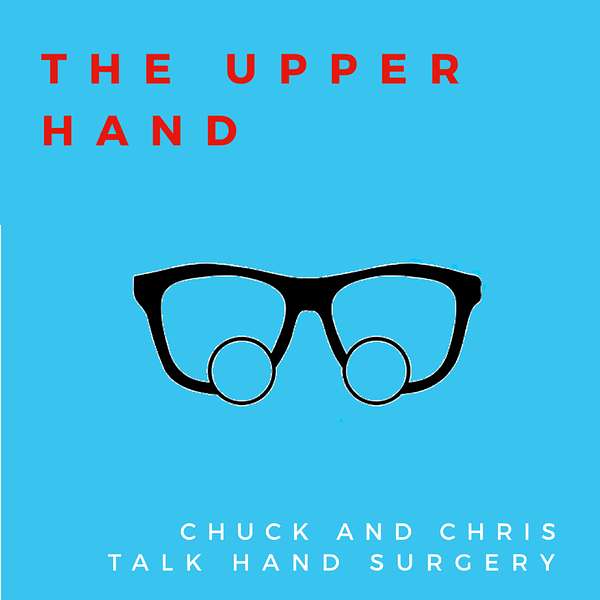
The Upper Hand: Chuck & Chris Talk Hand Surgery
The Upper Hand: Chuck & Chris Talk Hand Surgery
The Carpal Bones, More Fun Than You Think
Chuck and Chris discuss their thoughts/ the relevance of each of the carpal bones and we promise this episode is more fun that you may think. We discuss how we think about each bone, the pathology associated and the interventions we consider.
Thanks to all those who have taken our survey. For those who have not, please take 2 minutes and help us to better understand your preferences and help us understand how we can continue to improve the podcast! The survey will close on Friday July 11th. For those who complete the survey and share their email, we will have a drawing for Upper Hand Swag!
https://forms.gle/MXmPMwYLYfYa6E347
Keep a lookout for our Summer Newsletter- check your inboxes and let us know if you are not on the list and would like to be. Feedback always welcome.
See www.practicelink.com/theupperhand for more information from our partner on job search and career opportunities.
The Upper Hand Podcast is sponsored by Checkpoint Surgical, a provider of innovative solutions for peripheral serve surgery. To learn more, visit https://checkpointsurgical.com/.
As always, thanks to @iampetermartin for the amazing introduction and concluding music.
For additional links, the catalog. Please see https://www.ortho.wustl.edu/content/Podcast-Listings/8280/The-Upper-Hand-Podcast.aspx
Quick recap
Christopher and Charles discussed various aspects of hand and wrist anatomy, focusing on the carpal bones and their clinical relevance in surgical procedures. They explored treatment options for different carpal bone injuries, including fractures, arthritis, and avascular necrosis, sharing personal experiences and preferred techniques. The conversation also covered rehabilitation protocols and the importance of understanding wrist biomechanics in treating and managing hand and wrist conditions.
Podcast Topic: Carpus Discussion
They announced their upcoming podcast topic about the carpus, encouraging listeners to join their mailing list and complete a survey for a chance to win swag like Upper Hand coffee mugs and an OGIO backpack.
Trapezoid Bone: Clinical Relevance
Christopher and Charles discussed the often-neglected trapezoid bone in the carpus, noting its limited clinical relevance. They mentioned its importance in specific contexts, such as thumb CMC procedures and STT arthritis, but agreed it is rarely addressed. Charles shared a humorous anecdote from a past Stern reunion about a distal carpal resection involving the trapezoid and trapezium, which led to a discussion about the indications and technique for resecting the trapezoid. They concluded that while trapezoid fractures are rare, CMC joint instability issues are uncommon but can be managed with fusion if necessary.
Carpal Bone Surgery Focus: Capitate
Christopher and Charles discussed various aspects of carpal bone surgery, with a focus on the capitate. They explored when and how to fix capitate fractures, particularly in the context of perilunate injuries. Charles shared his experience with identifying the capitate during open approaches, noting its distinctive appearance. They also discussed the importance of the capitate in four-corner fusions, referencing a previous study by Calentruccio and Gelberman.
Hamate Bone Diagnoses and Treatments
Charles and Christopher discussed various aspects of hand surgery, focusing on the hamate bone and its surgical implications. They explored treatments for hamate fractures, including pinning and hemihamate arthroplasty, with Charles emphasizing that excision is typically the preferred treatment for hook of the hamate fractures. Christopher shared a personal experience with a patient who had persistent pain after a fall, highlighting the challenges of managing such cases without clear imaging findings. They also briefly discussed the use of checkpoint surgical's Gemini bipolar nerve stimulator in procedures like selective neurectomy for spasticity.
Pisiform Bone and Pisotriquetral Injection Techniques
Charles and Christopher discussed the pisiform bone, noting its importance in ulnar-sided pain and its potential for arthritis, subluxation, dislocation, and fractures, though the latter is uncommon. They highlighted the effectiveness of pisiform-triquetral injections in treating inflammation and joint pain, with Charles sharing his experience of using freehand injections while Christopher prefers ultrasound-guided injections. They also touched on triquetral fractures, particularly dorsal rim fractures, which can be challenging to heal and often require immobilization for several weeks.
Wrist Surgical Techniques Discussion
Charles and Christopher discussed surgical techniques for wrist procedures, focusing on carpectomy and four-corner fusion. They shared their approaches to addressing the triquetral-hamate articulation and the use of screws for fixation. Charles mentioned his preference for a home-run screw from a separate ulnar incision, while Christopher inquired about the visibility of the dorso-ulnar nerve during the procedure. They also touched on the challenges of lunate avascular necrosis and the importance of discussing dynamics and the trapezium in future discussions.
Scaphoid and Lunate Bone Challenges
Christopher and Charles discussed the anatomy and challenges of the scaphoid and lunate bones in the wrist, emphasizing their importance as the "cornerstone of the keystone." They explored the peculiarities of the scaphoid's blood supply and the risks of avascular necrosis at the proximal pole. They also discussed the treatment of scaphoid fractures and the use of cancellous bone grafts for four-corner fusion, with Charles noting that scaphoid cancellous bone is less effective than iliac crest bone. The conversation concluded with a brief mention of trapezium fractures, with Christopher sharing a recent case and emphasizing the potential for post-traumatic arthrosis.
Wrist Anatomy and Surgical Techniques
Charles and Christopher discussed wrist anatomy and surgical techniques, focusing on the trapezium bone and scaphoid. They emphasized the importance of not cutting certain ligaments during surgery and explained the concept of radial deviation in wrist motion. The conversation also covered the "dart thrower's motion" and its relevance to treating scapholunate injuries, with Charles sharing his approach to rehabilitation protocols. They agreed that motion exercises like dart throwers can be started around 6 weeks post-surgery, with strengthening typically allowed by 10 weeks.